牛津译林版八年级英语上册Unit 7 Seasons Reading1公开课课件
- 格式:ppt
- 大小:2.45 MB
- 文档页数:30
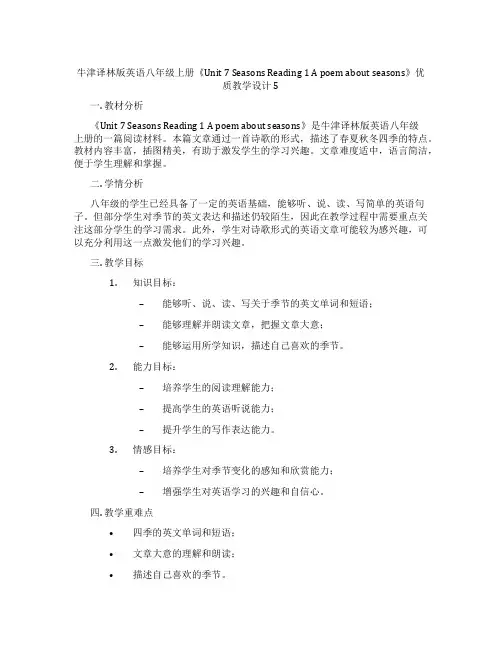
牛津译林版英语八年级上册《Unit 7 Seasons Reading 1 A poem about seasons》优质教学设计5一. 教材分析《Unit 7 Seasons Reading 1 A poem about seasons》是牛津译林版英语八年级上册的一篇阅读材料。
本篇文章通过一首诗歌的形式,描述了春夏秋冬四季的特点。
教材内容丰富,插图精美,有助于激发学生的学习兴趣。
文章难度适中,语言简洁,便于学生理解和掌握。
二. 学情分析八年级的学生已经具备了一定的英语基础,能够听、说、读、写简单的英语句子。
但部分学生对季节的英文表达和描述仍较陌生,因此在教学过程中需要重点关注这部分学生的学习需求。
此外,学生对诗歌形式的英语文章可能较为感兴趣,可以充分利用这一点激发他们的学习兴趣。
三. 教学目标1.知识目标:–能够听、说、读、写关于季节的英文单词和短语;–能够理解并朗读文章,把握文章大意;–能够运用所学知识,描述自己喜欢的季节。
2.能力目标:–培养学生的阅读理解能力;–提高学生的英语听说能力;–提升学生的写作表达能力。
3.情感目标:–培养学生对季节变化的感知和欣赏能力;–增强学生对英语学习的兴趣和自信心。
四. 教学重难点•四季的英文单词和短语;•文章大意的理解和朗读;•描述自己喜欢的季节。
•文章中部分长句子的理解和翻译;•诗歌形式的英语文章的阅读和理解;•运用所学知识进行实际交流。
五. 教学方法1.情境教学法:通过图片、视频等素材,创设真实的学习情境,引导学生参与课堂活动。
2.任务型教学法:通过小组讨论、角色扮演等任务,培养学生合作学习的能力。
3.交际式教学法:利用问答、对话等形式,提高学生的英语听说能力。
4.诗歌欣赏法:引导学生欣赏和感受诗歌的韵律和美感,增强学习兴趣。
六. 教学准备1.教材:牛津译林版英语八年级上册;2.多媒体设备:电脑、投影仪、音响等;3.教学素材:四季图片、视频、相关诗歌等;4.作业布置:提前准备相关练习题。
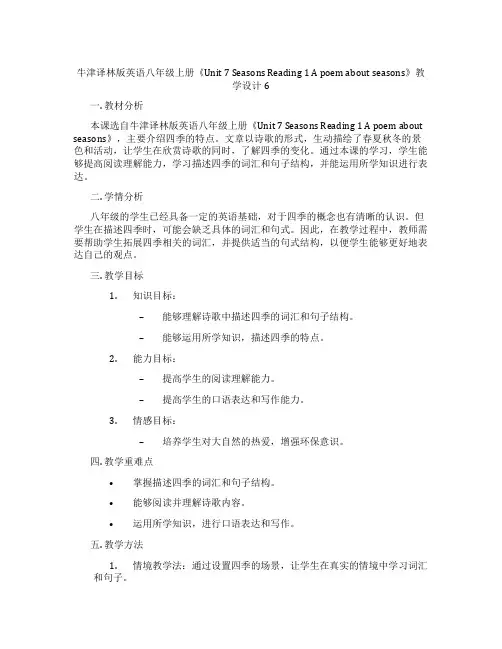
牛津译林版英语八年级上册《Unit 7 Seasons Reading 1 A poem about seasons》教学设计6一. 教材分析本课选自牛津译林版英语八年级上册《Unit 7 Seasons Reading 1 A poem about seasons》,主要介绍四季的特点。
文章以诗歌的形式,生动描绘了春夏秋冬的景色和活动,让学生在欣赏诗歌的同时,了解四季的变化。
通过本课的学习,学生能够提高阅读理解能力,学习描述四季的词汇和句子结构,并能运用所学知识进行表达。
二. 学情分析八年级的学生已经具备一定的英语基础,对于四季的概念也有清晰的认识。
但学生在描述四季时,可能会缺乏具体的词汇和句式。
因此,在教学过程中,教师需要帮助学生拓展四季相关的词汇,并提供适当的句式结构,以便学生能够更好地表达自己的观点。
三. 教学目标1.知识目标:–能够理解诗歌中描述四季的词汇和句子结构。
–能够运用所学知识,描述四季的特点。
2.能力目标:–提高学生的阅读理解能力。
–提高学生的口语表达和写作能力。
3.情感目标:–培养学生对大自然的热爱,增强环保意识。
四. 教学重难点•掌握描述四季的词汇和句子结构。
•能够阅读并理解诗歌内容。
•运用所学知识,进行口语表达和写作。
五. 教学方法1.情境教学法:通过设置四季的场景,让学生在真实的情境中学习词汇和句子。
2.互动式教学法:引导学生进行小组讨论,提高学生的参与度和积极性。
3.任务型教学法:通过完成具体任务,培养学生运用英语进行交流的能力。
六. 教学准备1.教师准备:–熟悉教材内容,明确教学目标。
–准备相关的四季图片、视频等教学资源。
2.学生准备:–预习教材内容,了解四季的基本概念。
七. 教学过程1.导入(5分钟)教师通过展示四季的图片或视频,引导学生谈论四季的变化,激发学生的学习兴趣。
2.呈现(10分钟)教师带领学生一起阅读诗歌,引导学生关注描述四季的词汇和句子结构。
在阅读过程中,教师适时提问,帮助学生理解诗歌内容。
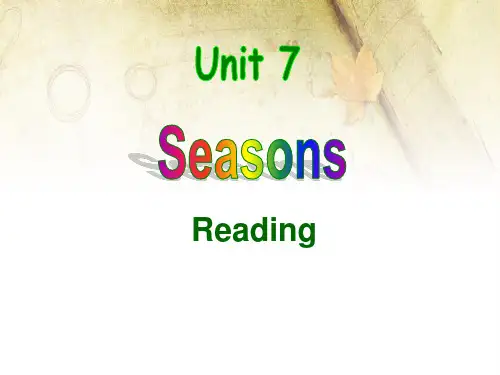
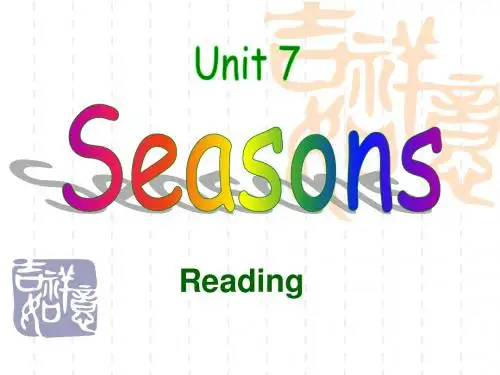
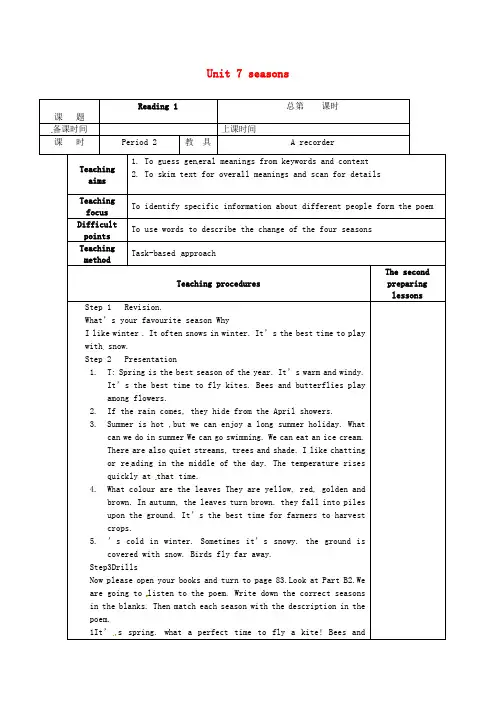
Unit 7 seasons Teachingaims1. To guess gen eral meanings from keywords and context2. To skim text for overall meanings and scan for details TeachingfocusTo identify specific information about different people form the poem DifficultpointsTo use words to describe the change of the four seasons Teachingmethod Task-based approachTeaching procedures The second preparinglessonsStep 1 Revision.What ’s your favourite season WhyI like winter . It often snows in winter. It ’s the best time to playwith snow.Step 2 Presentation1. T: Spring is the best season of the year. It ’s warm and windy.It ’s the best time to fly kites. Bees and butterflies playamong flowers.2. If the rain comes, they hide from the April showers.3. Summer is hot ,but we can enjoy a long summer holiday. Whatcan we do in summer We can go swimming. We can eat an ice cream.There are also quiet streams, trees and shade. I like chattingor re ading in the middle of the day. The temperature risesquickly at that time.4. What colour are the leaves They are yellow, red, golden andbrown. In autumn, the leaves turn brown. they fall into pilesupon the ground. It ’s the best time for farmers to harvestcrops.5. ’s cold in winter. Sometimes it ’s snowy. the ground iscovered with snow. Birds fly far away.Step3DrillsNow please open your books and turn to page 83.Look at Part B2.Weare going to listen to the poem. Write down the correct seasonsin the blanks. Then match each season with the description in thepoem.1It ’s spring. what a perfect time to fly a kite! Bees and课 题Reading 1 总第 课时 备课时间上课时间 课 时Period 2 教 具 A recorderbutterflies play among flowers.2 It’s autumn. Brown leaves fall on the ground. Farmers harvestcrops.3It’s winter. Winter days are full of snow. Birds fly far away.4It’s summer. There are quiet streams, trees and shade. We can eat ice cream.Step4Practice1What can we see in winter2Can trees and flowers grow in winter3Why do the birds fly far away1What can we do in spring2what do bees and butterflies do in sping1What can we do in summer2where can we often play in summer1Where can we see piles of autumn leaves2What are the farmers busy doing in autumnRead the poem again and find the rhyming words.Read the poem again ,and then disc uss and find the sentences in which the writer uses personification.Step5 ActivitiesPlease repeat the po em after the tape.Pay attentio n t o your pronunciation and intonation.Pl ease read the poem together and express y our feelings about each season.I’m going to divide you into four groups.Each group will read one of the seasons.Step 6HomeworkMaster the important words phrases and sentences.Recite the poemTeachingnotes第二课时课题Comic stri p and Welcome to the unit 总第课时备课时间上课时间课时Period 1 教具 A recorder and teaching picturesTeaching aims To revise vocabulary and expressions to describe seasons at the same time, learn more new words and phrases.Teaching focus 1. To revise vocabulary and expressions to describe seasons2. To guess meaning from context3. Talk about your favourite seasonsDifficult pointsTo master different ways of talking about weather TeachingmethodFree talk, Presentation, Practice, Consolidation.Teaching procedures The second preparing lessonsStep 1 PresentationTeach the new words such as sunny, cloudy ,windy and so on with the help of mediaAsk q uestions:What’s the weather like todayIt’s sunny\cloudy\windy……Present our students a picture of the rain. Look, It’s raining . The ground is all wet. It’s rainy.Look, It’s snowing heavily. The ground is all white. It’s snowy. Look! There is a lot of fog. We can’t see anything clearly. It’s foggy.Step2 PracticeDo the game one by on e.What’s the weather likeIt’s sunny.Now let’s play a game. The first student in each group will show the second student a weather card and ask him or her the question What’s the weather like The second student will answer the question and then ask the third one the same question. The team which finishes first and does the best will win the game.Step3 PresentationWhat’s the weather like in springIt’s the windy and rainy. It’s the best time for trees and flowers to grow. It’s the best time to fly kites.What’s the weathe r like in summer It’s sunny and hot. It’s the best time to g o swimming.What’s the weather like in autumn It’s sunny and cool. It’s the best time to plan a day out.What’s the weather like in winter It’s cold and snowy. It’s the best time to play with snow.Now let’s listen to a conversation and then answer some questions. 1Which season does Simon like best Why2Which season does Amy like best WhyStep4 PracticeNow work in groups of four and make a similar conversation. Comic stripStep1 Present ationWinter is coming. Eddie feels very cold. What does he want to do Now l et’s listen to the conversation between Eddie and Hobo, and then find out the answer. He wants Hobo to bring him clothes.Does Eddie look cool with the clothes Hobo thinks he’ll look cool and feel cool with nothing on.Step2 DrillsListen to the tape and repeat after it. Pay attention to the pronunciation and intonation.These two teams wil l read Eddie’s part and these two will read Eddie’s part and these two will read Hobo’s part.Step3 DisplayWork in pairs and read the conversation between Eddie and Hob o. You can add your ideas.Step4 HomeworkRecite the comic strip and Part BT eaching notes。
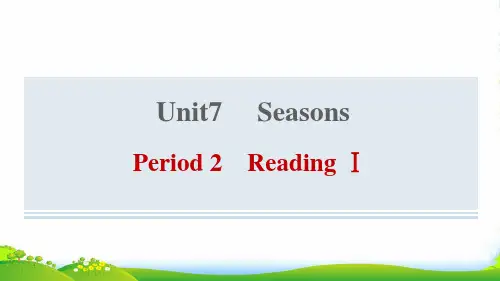
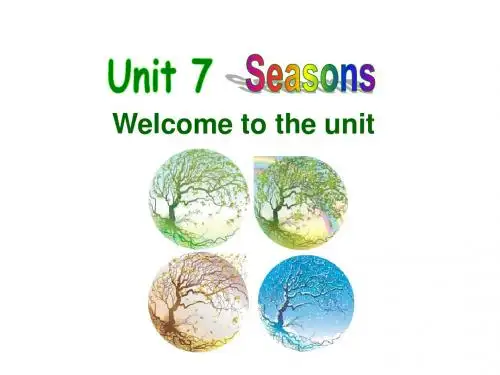
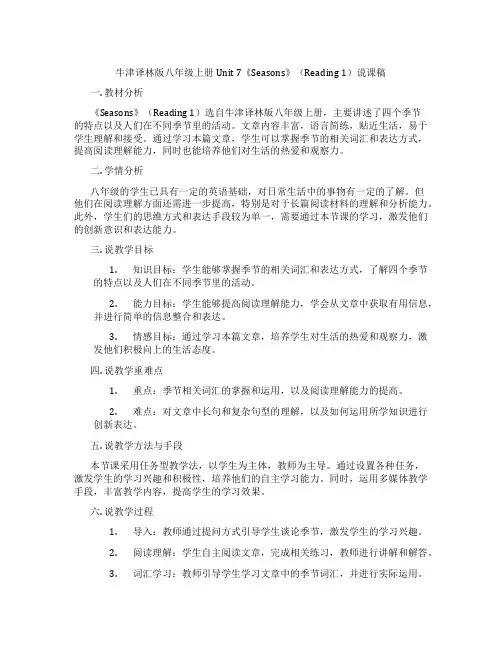
牛津译林版八年级上册Unit 7《Seasons》(Reading 1)说课稿一. 教材分析《Seasons》(Reading 1)选自牛津译林版八年级上册,主要讲述了四个季节的特点以及人们在不同季节里的活动。
文章内容丰富,语言简练,贴近生活,易于学生理解和接受。
通过学习本篇文章,学生可以掌握季节的相关词汇和表达方式,提高阅读理解能力,同时也能培养他们对生活的热爱和观察力。
二. 学情分析八年级的学生已具有一定的英语基础,对日常生活中的事物有一定的了解。
但他们在阅读理解方面还需进一步提高,特别是对于长篇阅读材料的理解和分析能力。
此外,学生们的思维方式和表达手段较为单一,需要通过本节课的学习,激发他们的创新意识和表达能力。
三. 说教学目标1.知识目标:学生能够掌握季节的相关词汇和表达方式,了解四个季节的特点以及人们在不同季节里的活动。
2.能力目标:学生能够提高阅读理解能力,学会从文章中获取有用信息,并进行简单的信息整合和表达。
3.情感目标:通过学习本篇文章,培养学生对生活的热爱和观察力,激发他们积极向上的生活态度。
四. 说教学重难点1.重点:季节相关词汇的掌握和运用,以及阅读理解能力的提高。
2.难点:对文章中长句和复杂句型的理解,以及如何运用所学知识进行创新表达。
五. 说教学方法与手段本节课采用任务型教学法,以学生为主体,教师为主导。
通过设置各种任务,激发学生的学习兴趣和积极性,培养他们的自主学习能力。
同时,运用多媒体教学手段,丰富教学内容,提高学生的学习效果。
六. 说教学过程1.导入:教师通过提问方式引导学生谈论季节,激发学生的学习兴趣。
2.阅读理解:学生自主阅读文章,完成相关练习,教师进行讲解和解答。
3.词汇学习:教师引导学生学习文章中的季节词汇,并进行实际运用。
4.任务型活动:学生分组讨论,根据文章内容创作关于季节的短文。
5.展示与评价:各小组展示自己的作品,全班同学进行评价和投票。
6.总结与反思:教师对课堂内容进行总结,学生分享自己的学习收获和感悟。
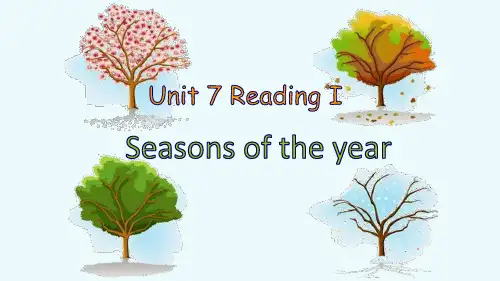
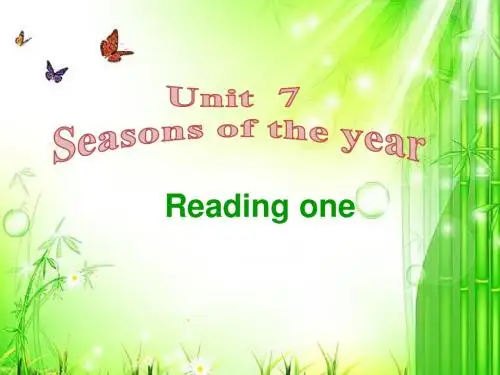
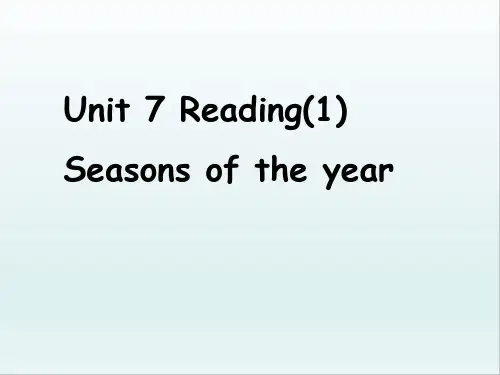
牛津译林版英语八年级上册《Unit 7 Seasons Reading 1 A poem about seasons》教学设计7一. 教材分析本课选自牛津译林版英语八年级上册Unit 7 Seasons Reading 1 A poem about seasons。
本篇文章是一首关于四季的诗歌,通过描述春夏秋冬四个季节的特点,让学生感受大自然的魅力。
文章语言优美,富有诗意,适合学生欣赏和品味。
本课的教学内容旨在帮助学生掌握季节相关的词汇和表达方式,提高学生的阅读理解能力,并培养他们对大自然的热爱和珍惜。
二. 学情分析八年级的学生已经具备了一定的英语基础,能够理解和运用一些基本的英语词汇和句型。
但他们在阅读理解方面还存在一定的困难,特别是对于长篇阅读材料的理解和分析能力。
此外,学生对季节的认识和体验各不相同,因此需要在教学中引导学生积极参与,分享自己的经验和感受。
三. 教学目标1.知识目标:学生能够掌握与季节相关的词汇和表达方式,如spring,summer, autumn, winter, warm, cool, hot, cold等。
2.能力目标:学生能够理解并朗读课文,提高阅读理解能力。
3.情感目标:学生能够珍惜大自然,热爱生活,感受四季变化的美妙。
四. 教学重难点1.重点:季节相关的词汇和表达方式。
2.难点:对课文的理解和朗读,以及对季节特点的描述。
五. 教学方法本课采用任务型教学法、情境教学法和交际法进行教学。
通过设定各种任务,让学生在实践中学习和运用语言;创设情境,让学生在真实的语境中交流;采用小组合作学习,促进学生之间的互动和合作。
六. 教学准备1.教师准备:课文翻译、相关季节的图片和视频、教学课件等。
2.学生准备:课本、笔记本、笔。
七. 教学过程1.导入(5分钟)教师通过展示季节变化的图片和视频,引导学生谈论自己喜欢的季节,并说明原因。
激发学生对季节的兴趣和好奇心。
2.呈现(10分钟)教师展示课文标题和图片,引导学生预测课文内容。
牛津译林版英语八上Unit 7《Seasons》(Reading 1)教学设计1一. 教材分析《Seasons》是牛津译林版英语八上Unit 7的一篇阅读文章,主要介绍了春夏秋冬四季的特点以及人们在不同季节里的活动。
文章内容丰富,语言简洁,贴近学生的生活实际,有利于激发学生的学习兴趣。
通过本篇文章的学习,学生可以增强对季节的了解,提高英语阅读能力,同时培养观察、思考、表达等综合语言运用能力。
二. 学情分析八年级的学生已经具备了一定的英语基础,对季节的概念也有了一定的认识。
但他们在阅读长篇文章时,可能会遇到生词、语法等困难,影响理解。
因此,在教学过程中,教师需要关注学生的个体差异,调动他们的学习积极性,引导他们主动探究、合作学习,提高阅读理解能力。
三. 教学目标1.知识目标:学生能够掌握文章中涉及的主要季节特点和活动。
学生能够正确运用文章中出现的关键词汇和句型进行表达。
2.能力目标:学生能够独立阅读并理解文章内容。
学生能够在教师的引导下,运用所学知识进行思考和表达。
3.情感目标:学生能够体验到学习英语的乐趣,增强对英语的热爱。
学生能够培养合作、探究的学习精神,提高自主学习能力。
四. 教学重难点学生能够掌握文章的主要内容,理解季节特点和人们在不同季节里的活动。
学生能够运用所学知识进行简单的交流和表达。
学生能够在阅读过程中,正确理解并运用文章中出现的生词、短语和句型。
学生能够在实际情境中,灵活运用所学知识进行表达。
五. 教学方法1.任务型教学法:通过设定各种任务,激发学生的学习兴趣,引导他们主动探究、合作学习。
2.情境教学法:创设真实、生动的学习情境,让学生在实际情境中感知、体验和运用语言。
3.交际法:注重学生之间的互动交流,提高他们的口头表达能力和交际能力。
六. 教学准备1.教师准备:备好教学PPT,设计好相关任务和活动。
2.学生准备:预习文章内容,了解四季的特点和活动。
七. 教学过程1.导入(5分钟)教师通过提问方式引导学生谈论四季,激发学生的学习兴趣。